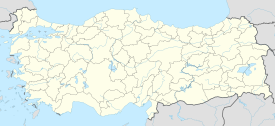Çavuştepe
| Çavuştepe Հայկաբերդ | |
|---|---|
| Gürpınar,Van,Turkey | |
 The ruins of Urartian Sardurihinilli. | |
| Coordinates | 38°21′09″N43°27′34″E/ 38.352443°N 43.459393°E |
| Type | Fortified City |
| Site history | |
| Built | 1st millennium BC |
| Built by | Sarduri II |
| Materials | Stone |
| Demolished | Partially |
Sardurihinilli,also known asHaykaberd(Armenian:Հայկաբերդ,lit. 'Fortress of Hayk') orÇavuştepe Kalesi,is an ancientUrartianfortified site located on a ridge on the northeastern edge of the village of Çavuştepe in theGürpınar districtofVan Provincein easternTurkey.It is located approximately 25 kilometers southeast ofVanalong the road leading to the city ofHakkâri,in a valley once known asHayots Dzorin historic Armenia. It was founded by the Urartian kingSarduri II(r. 764–735) some time during his reign in the 8th century BC and is believed to be identical with the fortress ofSardurihurdamentioned in the same king'scuneiforminscriptions.[1][2][3]
In Armenian folklore it is identified with Haykaberd or Haykʻ, the fortress built byHayk,the legendary founder of theArmeniannation, close to the site where he slew the invading Babylonian kingBel.
Site
[edit]

Sardurihinilli has a linear plan, perched upon a ridge overlooking the Gürpınar Plain called Bol Dağı. It is composed offortification wallsas well as the remains of an Urartian royal palace, built between 764 and 735 BC during the reign of KingSarduri IIat the climax of power of the Urartian Empire. There are upper and lower sections of the fortress in which the Temple ofKhaldior Irmushini, citadel walls, king's tower, workshops (7th century BC), storehouses, cisterns, kitchen, palace with a throne room, "royal" toilet, harem and colonnaded halls were located. A moat surrounded sections of the fortress.
The fortress stands out by the high quality of its masonry, which, in the view ofC. A. Burney,suggests that it was "a wealthy town, of which only the acropolis remains to this day."[2]Aside from the cyclopean wall, the blocks used in the fortress are smoothly finished and fit exactly together without mortar being used.[2]
If Sardurihinilli is to be identified with Sardurihurda, then it is located near the site of a city called Ulhu, which Assyrian inscriptions saySargon IIconquered during his campaign against Urartu, although it seems Sardurihurda did not fall to the Assyrians.[4]
Four Urartian cuneiform inscriptions have been discovered at Sardurihinilli, of which the best preserved one reads as follows:
This temple is dedicated to the god Irmushini; I, Sarduri, son ofArgishti,constructed it in a great feat when I took the throne in my father's place. Sarduri speaks: the rock was solid and nothing was built here. I,Khaldi,built this great temple to the god Irmushini and also a great fortress. I built a canal from the Gugunaini (Hoşap), I erected vineyards, ploughed fields; I built a new city here, created great monuments, established the name of Sardurihinili. Sarduri speaks: life and glory, as well as rule, power, strength, and happinness to Sarduri, son of Argishti, from Khaldi, from the Khaldian gates, and from the god Irmushini. Sarduri, the powerful king, the great king, the king ofBiainili,ruler of the city ofTushpa.[5]
Sardurihinilli was destroyed in the 7th century BC, presumably by the Scythians orMedes.Traces of a later medieval occupation exist. In 1884, a cuneiform inscription from the site was taken to Vienna and published byD. H. Müller.[6]Nikolai MarrandJoseph Orbelivisited the site in 1916 and collected some artifacts that are now located at theHermitage.[6]Carl Friedrich Lehmann-Hauptwas the first to conduct excavations at the site and draw up a sketch-plan of the fortress.[6]C. A. Burney visited the site in 1956 and published a brief description and sketch-plan of the fortress.[7]The site was excavated between 1961 and 1986 by Afif Erzen.
Notes
[edit]- ^Karapetyan 2015,p. 63.
- ^abcBurney 1957,p. 46.
- ^Yesayan & Kilimjyan 1991,p. 103.
- ^Zimansky 1985,p. 42.
- ^Karapetyan 2015,p. 71.
- ^abcYesayan & Kilimjyan 1991,p. 102.
- ^Burney 1957,pp. 45–47.
Sources
[edit]- Belli, O. (2001).Çavuştepe (Šardurḫinili) Excavations.In: O. Belly (ed.):İstanbul University’s Contributions to Archaeology in Turkey 1932-2000.Istanbul, pp. 173–178.
- Burney, C. A. (1957)."Urartian Fortresses and Towns in the Van Region".Anatolian Studies.7:37–53.doi:10.2307/3642346.ISSN0066-1546.
- Erzen, A. (1978).Çavuştepe I. M. Ö. 7.-6. Yüzyil Urartu Mımarlik Antilari ve Ortaçağ Nekropolü.Ankara.
- Erzen, A. (1978):Ausgrabungen auf der urartäischen Burg Çavuştepe im Gebiet von Van.In: E. Akurgal (ed.):The Proceedings of the Xth International Congress of Classical Archaeology, Ankara-İzmir, 23-30.9.1973.Ankara, pp. 55–59.
- Karapetyan, Samvel(2015).Հայոց Ձոր[Hayotsʻ Dzor] (in Armenian). Yerevan:Research on Armenian Architecture.ISBN9789939843216.
- Yesayan, S. A.; Kilimjyan, G. S. (1991)."Հայկաբերդ ամրոցը"[Haikaberd castle].Lraber Hasarakakan Gitutyunneri(in Armenian).6(6): 102–113.ISSN0320-8117.
- Zimansky, Paul (1985).Ecology and Empire: The Structure of the Urartian State(PDF).Oriental Institute of the University of Chicago.ISBN0-918986-41-9.OCLC469553313.
See also
[edit]External links
[edit]Photos
[edit]- Haykaberd/CavustepeArchived2016-03-03 at theWayback Machine
- Photos of Haykaberd/CavustepeArchived2011-07-17 at theWayback Machine

